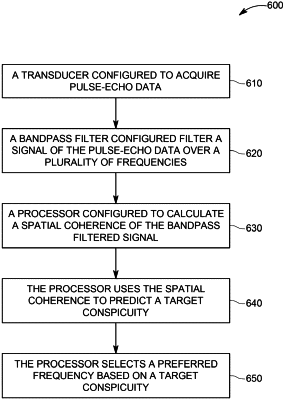| CPC A61B 8/14 (2013.01) [A61B 8/5207 (2013.01); G01S 15/8954 (2013.01); G01S 15/8959 (2013.01)] | 15 Claims |

|
1. A system comprising:
a transducer to:
output a first ultrasonic signal that bounces off a target and produces an ultrasonic echo signal,
receive the ultrasonic echo signal,
convert the ultrasonic echo signal to an electrical signal that spans a frequency range and represents a first image of the target; and
a processor to:
obtain a set of two or more sub-signals from the electrical signal, wherein each of the sub-signals spans a respective frequency sub-range of the frequency range,
compute, for each of the sub-signals, a respective plurality of spatial coherence metric values,
determine, for each of the sub-signals, a respective value of a conspicuity metric based on the respective plurality of spatial coherence metric values, and
select a frequency sub-range of the respective frequency sub-ranges based on the conspicuity metric values, wherein the selected frequency sub-range is for a second ultrasonic signal, the second ultrasonic signal for obtaining a second image.
|